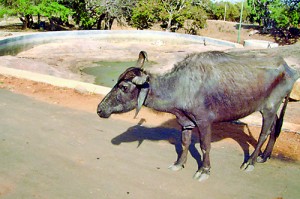News
Light rains make no dent in punishing drought
Despite minor showers in some drought-affected areas over past days more than 1.6 million people continue to suffer from the impact of the arid weather.
Many people are still forced to walk or cycle several kilometres to fetch water while farmers have been left idle in most of the drought-hit areas, leaving questions about the next season’s cultivation.

Scenes at Yala National Park. Pix by Janath de Silva
Polonnaruwa, Batticaloa, Kilinochchi, Monaragala, Ampara, Trincomalee, Kurunegala and Hambantota are among the districts affected by the harsh weather.
Batticaloa and Polonnaruwa were the worst-affected areas, the Department of Disaster Management said. About 252,673 people are in hardship in Batticaloa and 147,435 in the Polonnaruwa district.
Batticaloa District Secretary Mrs. P.A.S.M. Charles said a shortage of drinking water was the main problem there, rather than cultivation as Batticaloa farmers had completed their cultivation earlier and carried out their harvesting.
Mrs. Charles said small tanks and irrigation canals in the area were being renovated and deepened to collect more water in the rainy season.
Polonnaruwa District Secretary Nimal Abeysiri said authorities were continuing to send out bowsers to provide water to settlements while villagers also went out looking for water.
In Jaffna, Mullaitivu, Ampara, Badulla and other areas too people are depending on bowsers to provide their basic water needs as natural sources have nearly dried up.
Despite heavy rains two weeks ago Jaffna was still gripped by drought in some areas and the situation could get worse, Jaffna District Secretary Sundaram Arumainayagam said.
In Ampara, District Secretary Mr. Neil De Alwis said 23,000 people had a shortage of drinking water while 7,000 people had no water for their crops.
Bowsers were going from house to house and 1,000-2,000-litre water tanks had been set up in public and religious places and replenished every three days.

Scenes at Yala National Park. Pix by Janath de Silva
Dry rations were being distributed to the needy, he said, and officials were estimating the damage to the crops in order to give farmers some compensation for loss of income.
In Mullaitivu, District Secretary Nagalingam Vethanyahan said the area was still struck by drought.
“We have small showers yet the wells are dry and tanks still have very little water.”
Rainfall has been decreasing since 2012, he said.
Last year, farmers had used water from 2012 to cultivate about 13,000 acres for the 2013 “Yala Kanna” season but during the last season only 1,000 acres could be cultivated due to lack of water, Mr. Vethanyahan said.
He said farmers who had lost their harvest were being given an allowance through a new program in which they were assigned to clean the water canals as well as deepening tanks to hold more water in the next rains.
In Badulla, Ridimaliyadda, Hai-Ela, Kandaketiya, Meegahakiwla, and Swarnathota were badly affected.
The Minister of Disaster Management Mr. Mahinda Amaraweera said
said his ministry’s program saw affected farmers earning Rs. 6,000 for cleaning tanks and other irrigation works as a drought relief measure.
He said that the Ministry has spent around Rs. 1,500 million on drought assistance and had distributed more than 15,000 1000-litre tanks.
The minister said projects were underway to retain water in the country’s 33 rivers.
| Lanka may become hotter, warn climate experts
By Pushpakumara Jayaratne Sri Lanka is facing a major climate change as experts warn that the temperature may rise by two degrees centigrade in the near future. Climate experts at a recent workshop held at the Asian Disaster Management Institute (ADMI) in Thailand requested Sri Lankan authorities to take precautionary steps to prevent any disastrous situation that could be triggered by this condition. The ADMI has researched and identified the climatic catastrophe by programming weather data for a period from 2011 to 2040 based on statistics of the past 30 years and established the reasons for the current drought and the unpredictable rainfall that can lead to major floods. They explained that the findings show periodical rains that continue for three days followed by the dry season, which Sri Lanka is facing now, is an effect of the climate hazard. The rise of the present temperature by two degrees centigrade will have a detrimental effect on the country’s weather pattern, they said. ADMI has apprised the Sri Lankan authorities of steps that could be taken in disaster management if the need arose. Kurunegala Pradeshiya Sabha chairman Patrick Karunasinghe and North Western Province Local Government Commissioner Buwaneka Herath along with Pradeshiya Sabha members participated in the workshop. |

